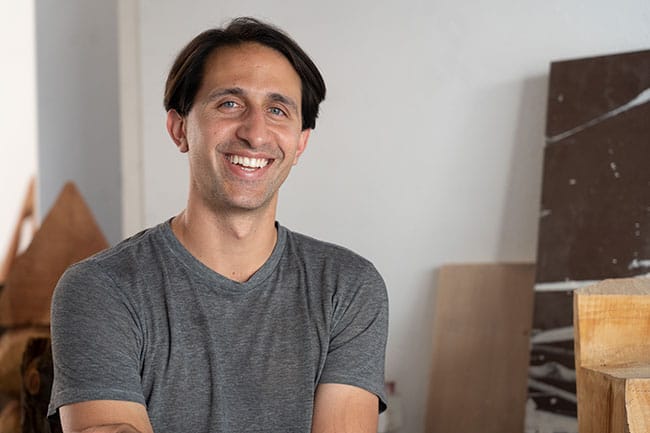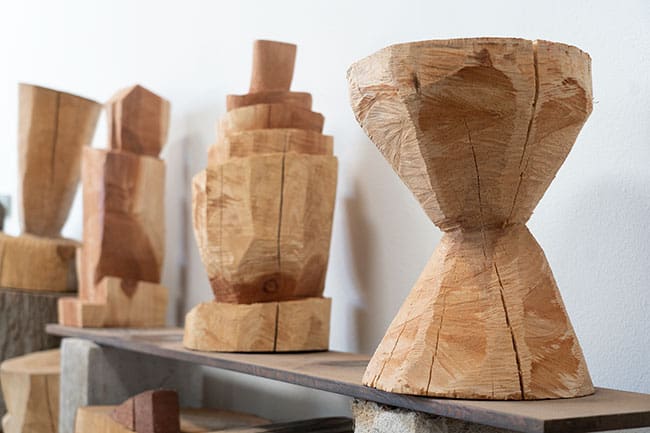Sculptor turns windstorm castoffs into functional art – with podcast

by Mick Rhodes | mickrhodes@claremont-courier.com
When winds in excess of 70 mph whipped through Claremont the evening of January 21, they uprooted hundreds of trees and left the city shaken, its streets awash in massive, mature trees, limbs and other debris.
Though thankfully there were no storm-related serious injuries to humans, an astounding amount of our storied urban forest — estimates put the number of felled trees in excess of 300 — were casualties.
Trees provide much more than oxygen and shade canopy to Claremonters: along with the Colleges, our architecture, and our Village, they’re an obvious major component of the City of Trees’ identity, and in fact, are the primary feature of the city’s logo.
Removing the detritus was arduous and expensive work. Much of the wood, branches and leaves returned to the earth as mulch. Still, many residents looked upon the task through a funereal lens; it seemed as if mother nature had struck at the core of the city.
But tucked in among the devastation was Vince Skelly. The 35-year-old Claremont native and wood sculptor made a series of rescues of sorts, scooping up felled cedar, redwood, pine and sweetgum logs with his crane-equipped truck. After unloading the massive logs in his Guadalajara Place yard, he went about transforming them into art.
Now, the metamorphosis is complete. The storm losses are now functional art: chairs, stools, benches and tables, all part of Skelly’s first solo show, “Vince Skelly: After the Storm, a collection of wooden monuments,” at Farago Gallery, 322 S. Broadway Ave., second floor, Downtown Los Angeles. An opening reception takes place from 3 to 6 p.m. Friday, July 1. The show will be on view from July 2 through July 13. The gallery is open Wednesday through Sunday from noon to 6 p.m.
Skelly was born and raised in the City of Trees, graduating from Claremont High in 2005. He moved away in 2009 for college at San Francisco State University, graduating in 2011 with a degree in graphic design. After that he lived in Portland for a decade. He and his wife moved back to Claremont in October 2021.
Not included in “Vince Skelly: After the Storm” is a piece he is making from a huge, ancient Live Oak that fell in Memorial Park in front of Garner House on January 21.
“It was special because I used to go to that park as a kid,” Skelly said. “I’d go to concerts in the park, and I went to Sycamore, and after school hanging out in that park, climbing on trees, playing on the playgrounds … all of that. So it was a really special tree to get my hands on.”
He’s currently in the planning stages of a sculpture from the tree he will, when complete, donate back to Memorial Park.
Skelly began carving about six years ago, inspired by Handcrafted Modern, a photo book of the interiors of artist-built homes. One of those artists, J.B. Blunk, created a particularly intoxicating home in Inverness, California.
“Seeing the house that he built by himself, and seeing his sculptures kind of scattered around his property, and seeing the inside of his having a lot of his sculptural elements built into it, inspired me to think about wood carving and wood sculpture,” Skelly said.
That spark would gestate for a decade though, as he delved into research, learning about other sculptors, their processes, tools, and about the properties of the various woods used in the art form.
Space was also an issue, as even smaller sculptures start as logs. After buying a home in Portland after college, he finally had a place with a garage and a backyard, which allowed him room for raw materials. Confident enough to begin to delve into what had become a 10-year obsession, the early results exceeded expectations.
“It was immediately satisfying, because the results are so fast with a tool like the chainsaw. You’re removing so much material so quickly, doing a lot of rough cuts,” Skelly said. “But it was an immediate satisfaction and gratification.”
After a few months of fits and starts, during which he experimented on various wood types, he grew more confident. His first finished piece was a cylindrical, hourglass shape about 18” tall.
Each piece begins with him living with the raw materials for a bit. In time, a piece of wood or log suggests a form. With a sketch in mind, or literally drawn with chalk on the wood, be begins with rough chainsaw cuts. In Skelly’s hands, what many might consider to be a somewhat blunt instrument is more like a brush in a painter’s. Over the years he’s learned to use it for very precise cuts, and it’s the tool he uses on about 90% of each piece.
Once the concept is roughed out with the chainsaw, he uses chisels, gouges, files and rasps. After that comes the sanding and leveling stage, which can involve joinery for cracks, and finally, finishing oil.
Working with “greenwood,” or freshly cut wood pieces, is tricky. As it dries over time, wood contracts, and as moisture dissipates, cracks can form, much like with vintage musical instruments such as guitars.
“It’s just like the guitars you’re describing, where these things are constantly changing,” Skelly said. “I now they’re going to change, because I’m carving greenwood a lot of the time, which has a lot of moisture in it.”
His goal is to get his pieces to a somewhat stable point before they’re sold. He uses a kiln to dry the wood as much as possible, a moisture meter to measure water content, and takes into account how long each particular piece has been on the ground. But cracks and other by-products of drying are unavoidable.
“I embrace that part of the process,” Skelly said. “It’s just a reminder that it’s an organic, living thing, and it’s going to do what organic things do and kind of ebb and flow and change with the seasons. I think all the cracks and patina that it gets over time is something to be happy about and embrace. I think, again, it’s a reminder that you’re working with organic material, and the nice interesting, great thing about working with wood is it does have those characteristics, as opposed to carving out of something like marble or stone that’s not going to change over time.”
Skelly’s pieces take dozens of hours each to complete, and their price tags reflect that significant labor: among the pieces included in “Vince Skelly: After the Storm,” are smaller stools at $3,000-$5,000. Chairs and small side tables run $5,000-$8,000, benches $9,000-$16,000, and a 12’ long table is ticketed at $40,000.
A preview reception for “Vince Skelly: After the Storm, a collection of wooden monuments,” takes place from 3 to 6 p.m. Friday, July 1 at Farago Gallery, 322 S. Broadway Ave., second floor, Downtown Los Angeles. It will be on view from July 2 through July 13. The gallery is open Wednesday through Sunday from noon to 6 p.m.
More information is at www.vinceskelly.com.











0 Comments
Trackbacks/Pingbacks